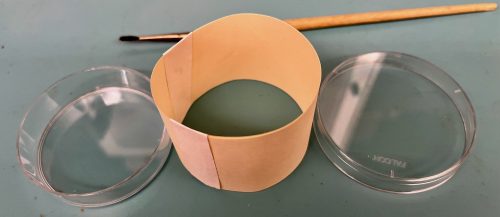I’ve been struggling to document pigmentation changes in my developing Steatoda triangulosa because they’re annoyingly alive. They’ve got preferences — they like to hang upside down, they will occasionally move, they are not being obliging as far as photography goes. They’re as lovely as a supermodel, but they’re also somewhat diva-ish and uncooperative. When I tell them to pose, or spread those legs, or look at the camera, they just ignore me. It also doesn’t help that I’ve got them living in these rigid containers, and if I shoo them out into a more photogenic location they get agitated and skitter about.
So I thought of a better way to manipulate them. Behold, Spider Studio Mk. I!
As usual, simple is better. All this is is a strip of paper curled into a cylinder, held together with two pieces of tape, sandwiched between the top and bottom of a petri dish. It’s ridiculously simple. The first test was to put a spider in there and see what they thought of it. They liked it! They built a cobweb in there and were hanging there, as always, when I came in this morning. Big bonus: they seem to prefer attaching silk to the paper walls than to the plastic dishes. I simply took away the petri dishes, leaving me with a nice calm undisturbed spider hanging in a paper hoop. I could orient the ring any way I wanted without stressing the spider at all!
I took a few pictures of my test subjects (I’ll put them on my Patreon for anyone who really wants to see them). It was great. I could take a picture of the dorsal side, and then flip the ring and take an equivalent picture of the ventral side.
I still have to make a few refinements. The paper ring is a bit thicker than necessary, and it still gets in the way when oriented to certain angles, so I’ll make thinner ones. I’m also going to stick some paper handles to the outside so I can use these soldering helping hands I’ve got to hold them in place.
There’s nothing I can do to cope with these being living animals. They still like to shuffle around on their web, but minimizing manipulation reduces that.
More progress!





Hah. When I was working with leather, I saw some of these household spiders in the leather tube chilling out in their webs. It appears they like the insides of tubes. I had to disturb them, unfortunately.
Maybe you could get your hands on some of the thick paper tubes on which cloths, carpets, and similar things are sold in bulk? Twenty years ago I got some for free from a carpet shop and I used them to make some furniture legs from them (I was very poor). They are light but sturdy, and it would be easy to glue handles to them. And from one such tube you could get probably a dozen of comfy spider abodes.
The thin paper works fine, and it’s nice and light. These are very small spiders!
The mad perfesser’s vats are made of paper, duck tape, and small bowels containing secret sooper growth-a-giant sauce.
If you can’t get them to do what you want, there’s always room for another paper confirming the Harvard Law of Animal Behavior.
Blf @ 3
Numerous films during the 1950s showed how easy it is to induce gigantism in various species of arthropods. The problem is keeping them contained. I suggest finding some uninhabited island near the Japanese coast.
I’ll recommend making hoops in black and white paper, depending on the dominant shades of the spiders you wish to photograph. Use as needed for best contrast.
Have you thought about some second-hand cannabis smoke? But if that works to calm them down for a bit you will have to be ready to placate them with vast amounts of tasty spider munchies.
@5 Birgerjohansson
You need never go any farther than your nearest nuclear waste dump site.
That Third Hand brings back memories from over 40 years ago when I was doing soldering on circuit boards. That made it so much easier. I still have it in a tool box that I haven’t opened in many years.
@6 It might be better to just make the inside alternate white and black – the odds are a small rotation won’t matter. Or perhaps better just use thin enough white or light gray paper that you can illuminate the outside of the tube when you want it light and slide a dark tube over it when you want it dark.
Spider Oragami.
“There’s nothing I can do to cope with these being living animals. They still like to shuffle around on their web”
I’m just spitballing here, but would setting the ring over a tiny piece of dry ice help? The colder temperature plus the excess CO2 might calm the beasties down? Or it might kill them, IDK.
You’re all making it complicated again! No patterns in the paper ring; the ring isn’t even in any of the photos. No anesthesia, either, since the manipulation will get them agitated (I have a baking soda & vinegar bottle & hose in the lab, if I want to knock one out). They tend to react strongly to cold — they don’t like it. And risk of killing them is a bad idea when you’re doing a longitudinal developmental study.
“(I have a baking soda & vinegar bottle & hose in the lab, if I want to knock one out).”
OK good, I thought I remembered that CO2 can knock out some small critters, but I wasn’t sure.
“They tend to react strongly to cold — they don’t like it.”
All right, I learned something today.
OT
Arachnids and insects: Vinced Rhino has a one -hour podcast.
“Noah left the insects behind”
https://youtu.be/HRyhssbJH6k